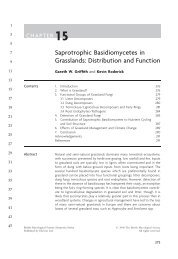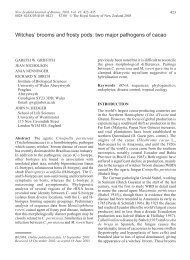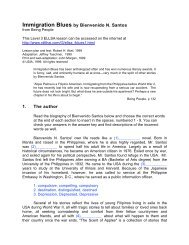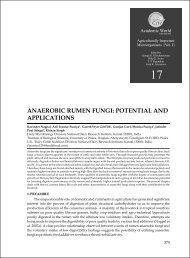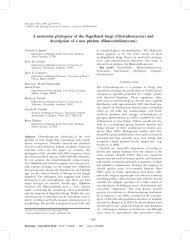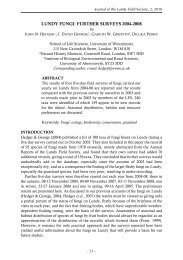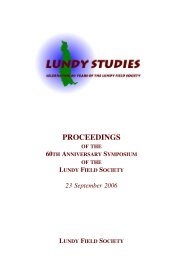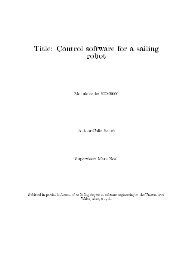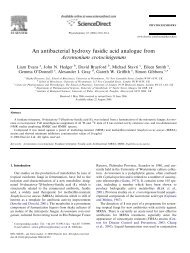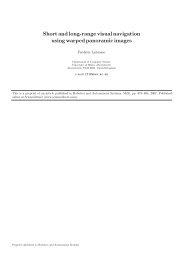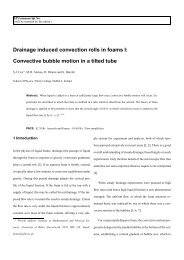Download the pdf - Users Site
Download the pdf - Users Site
Download the pdf - Users Site
You also want an ePaper? Increase the reach of your titles
YUMPU automatically turns print PDFs into web optimized ePapers that Google loves.
apo<strong>the</strong>cia (discomycetes). Unlike <strong>the</strong> pyenomycetes <strong>the</strong>y do not seem to be usually<br />
primary decomposers, but colonise wood in an advanced state of decay. The<br />
commonest are grey apo<strong>the</strong>cia produced by Mollisia species (Plate 6). These may<br />
occur alongside <strong>the</strong> attractive bright yellow apo<strong>the</strong>cia of Bisporella citrina.<br />
O<strong>the</strong>rs of <strong>the</strong>se minute discomycetes occur on specific hosts, for example troops<br />
of <strong>the</strong> beautiful, but minute, white discs of Hyaloscypha stevensonii are only found<br />
on undersides of well-decayed fallen branches of Corsican pines, Pinus nigra var.<br />
maritima, in <strong>the</strong> Millcombe Valley. Alongside <strong>the</strong>se discomycetes on <strong>the</strong> well-rotted<br />
pine wood can be found ano<strong>the</strong>r group of organisms, <strong>the</strong> myxomycetes, or slime<br />
moulds, which although protistans, and not true fungi, produce minute fungal-like<br />
fruiting bodies. Their plasmodia feed on <strong>the</strong> previous fungal and bacterial colonisers<br />
in <strong>the</strong> wood prior to fruiting. Species found to date include <strong>the</strong> pink Arcyria denudata,<br />
<strong>the</strong> intriguingly basket-shaped Comatricha nigra and <strong>the</strong> yellow pin-headed Trichia<br />
varia. On <strong>the</strong> drier upper surface of <strong>the</strong> pine logs, <strong>the</strong> confusingly similar, yellow,<br />
button-shaped, minute gelatinous fruit bodies of Dacrymyces stillatus may be found.<br />
This is actually a basidiomycete fungus. The fruit bodies are very tolerant of drying<br />
and <strong>the</strong> species is also a successful coloniser of <strong>the</strong> tops of fence posts and gates all<br />
over <strong>the</strong> island. It is closely related to <strong>the</strong> ‘jelly fungus’, Tremella mesenterica,<br />
whose orange gelatinous fruit bodies occur on dead wood of gorse, and to <strong>the</strong> ‘ear<br />
fungus’, Auricularia auricula-judae which colonises dead elder and is common in <strong>the</strong><br />
Walled Garden in Millcombe Valley. Interestingly <strong>the</strong>se three gelatinous species are<br />
amongst <strong>the</strong> earliest records of fungi from Lundy (Walker & Langham, 1971),<br />
probably because of <strong>the</strong> durability of <strong>the</strong>ir fruit bodies and lack of seasonality.<br />
There are fewer fungi on Lundy which cause brown rot decay of wood, <strong>the</strong> most<br />
common being <strong>the</strong> yellow to orange-brown, crust-like fruit bodies of <strong>the</strong> ‘polypore’<br />
Coniophora puteana and <strong>the</strong> related species, C. arida, which are very abundant on<br />
<strong>the</strong> many dead treated stumps of rhododendron by <strong>the</strong> side of <strong>the</strong> coastal path in <strong>the</strong><br />
east side clearance areas, and which are slowly reducing <strong>the</strong>se stumps to brown<br />
powder. Normally <strong>the</strong>se species are recorded from conifer wood. Interestingly, many<br />
rhododendron stumps are also colonised by white rot fungi. These include <strong>the</strong><br />
‘sulphur tuft’ agaric, (Hypholoma fasciculare) (Plate 7) which forms clumps of<br />
sulphur yellow toadstools. Where <strong>the</strong> species occur toge<strong>the</strong>r, contrasting brown and<br />
white rot can be seen in <strong>the</strong> same stump. In passing it should be noted that <strong>the</strong><br />
bonfires in this area have stimulated <strong>the</strong> autumn fruiting of troops of a small browncapped<br />
agaric, Pholiota carbonaria, which is restricted to burnt ground.<br />
Mycorrhizal Fungi and Woodland Litter Decomposer Fungi<br />
Under <strong>the</strong> trees, <strong>the</strong> fungi that are found fruiting on <strong>the</strong> soil or litter are ei<strong>the</strong>r<br />
mycorrhizal, associated with <strong>the</strong> roots of <strong>the</strong> trees, or are decomposer fungi, breaking<br />
down <strong>the</strong> leaf and twig litter. The mycorrhizal species recorded to date are large and<br />
obvious late summer/autumn macrofungi, including agarics and boletes in <strong>the</strong> genera<br />
Lactarius, Russula, Cortinarius, and Boletus and <strong>the</strong> ‘earth ball’ (Scleroderma<br />
citrinum). They represent some of <strong>the</strong> earliest observations of fungi on Lundy in <strong>the</strong><br />
early 1970s (Walker & Langham, 1971; Walker, 1972). Examples found in our 2003<br />
- 146 -



